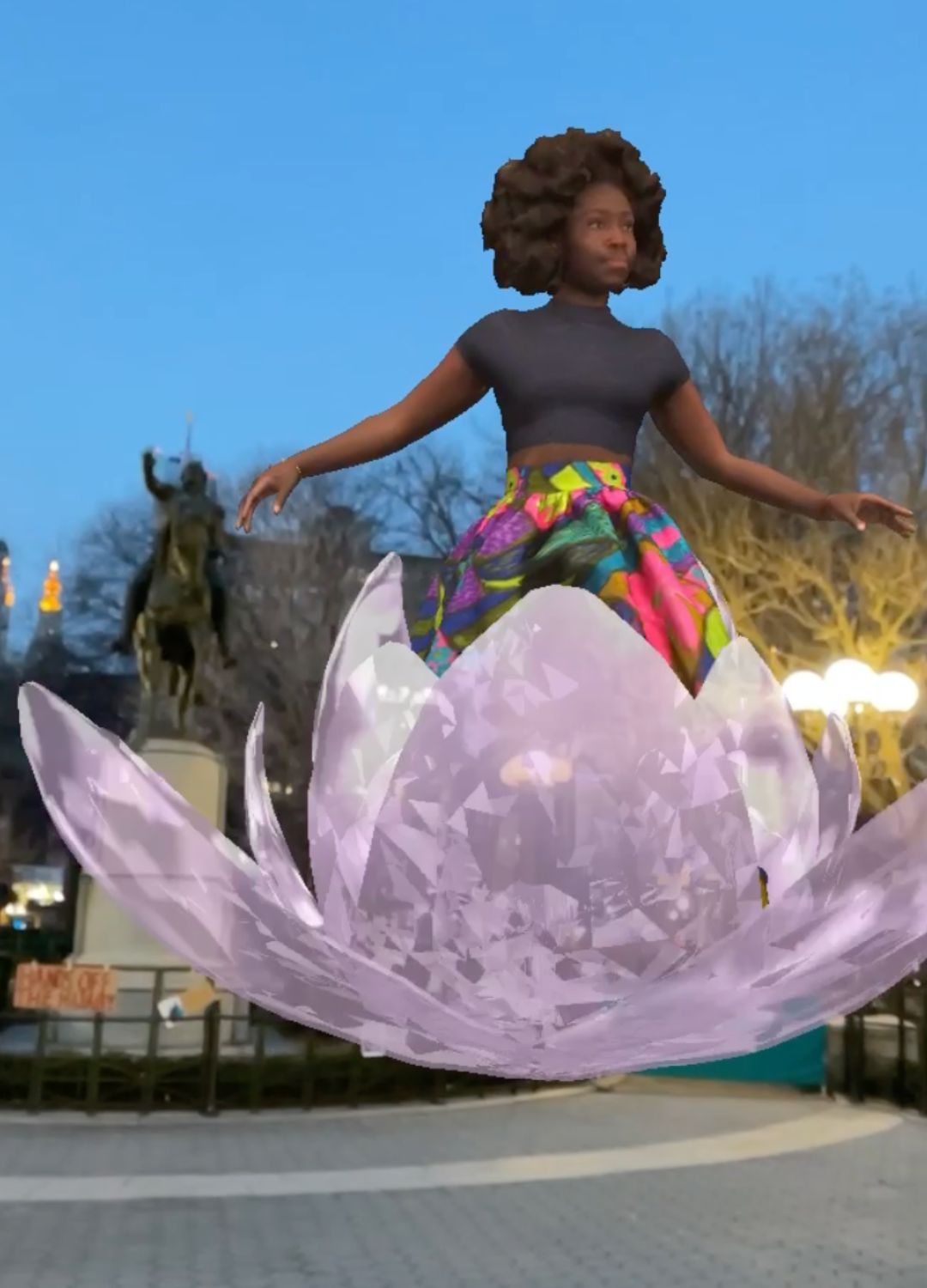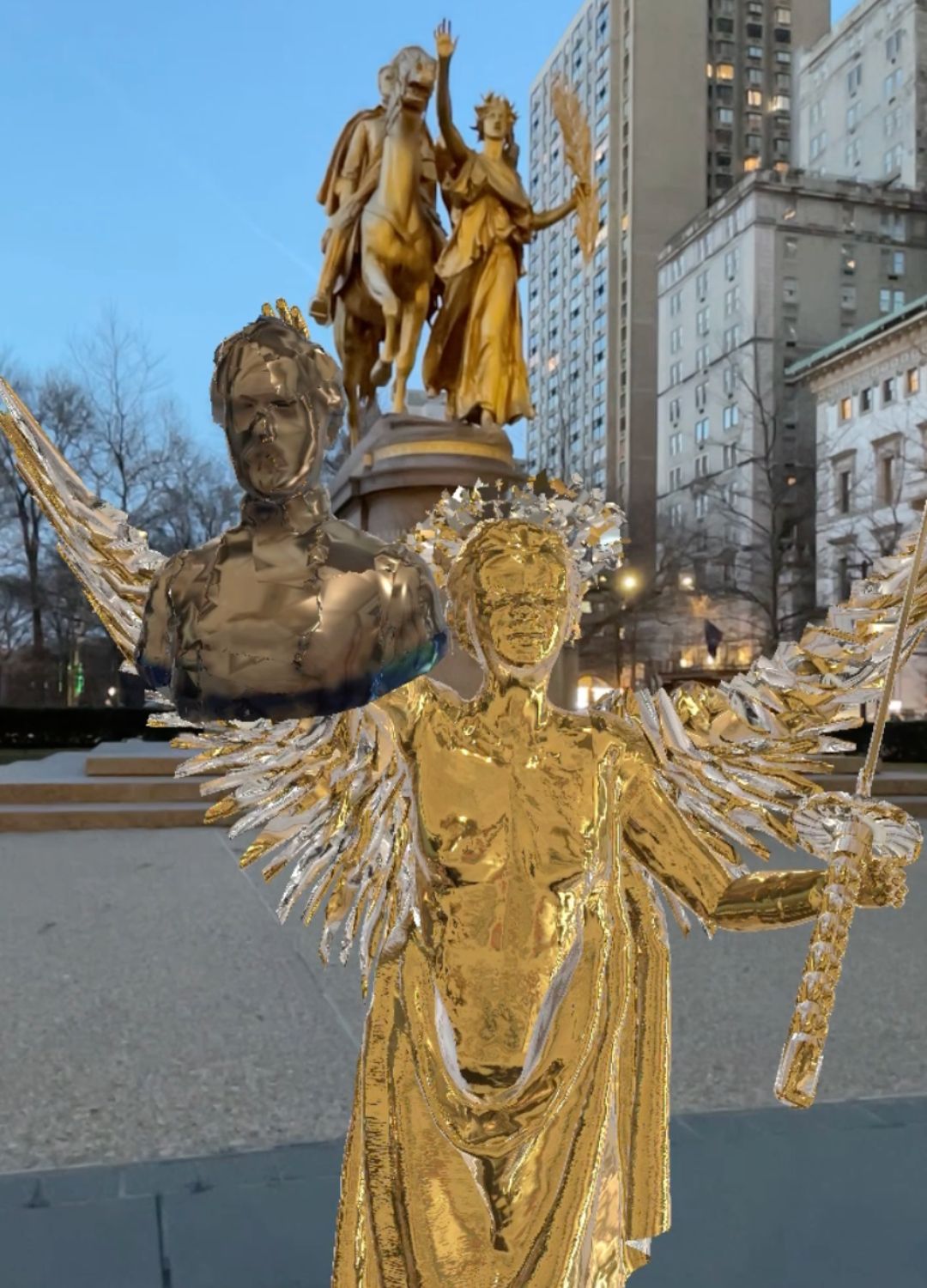

1. Introduction
In response to the conference theme, "Reinvention & Responsibility," we present
ARORA
, a pioneering project that started under the hashtag #MakeUsVisible co-founded by Anne Wichmann, Clara Francesca, Katie Peyton Hofstadter and Nam Le. The exhibition series is aimed at reshaping public landscapes in the US and all over the world through the integration of gender-diverse Augmented Reality (AR) and sound monuments. The initiative seeks – parallel to physical movements like
Statues For Equality
– to redress the current imbalance in public monuments, where in nearly all cities more than 90% depict male figures
(
Example NYC: Offenhartz, Jake in The Gothamist
), predominantly white, often glorifying war, and where non-male representation is strikingly scarce: In most cities we see more horses than women on pedestals
(Bader Media Group on PBS)
.


Left: “Cassandra” by Eva Davidova & Shirin Allen (paired with Washington on a horse at Union Square, NYC);
Right: “Hettie Anderson” by Sue Roh (paired with Sherman on a horse at Grand Army Plaza, NYC)
2. Commemoration and Augmented Reality
ARORA introduces a network of digital monuments strategically placed in public spaces: The digital monuments are paired with physical (male) sculptures to create a new balance, present a more inclusive picture and to fill in historical blanks ( O’Grady, Megan in T Magazine ). An exception is the city of Worms (Germany) where most of the AR statues are placed in locations where the women lived and/or worked.
ARORA aims to contribute to the ongoing discourse on reshaping public narratives through innovative, inclusive digital interventions. We leverage XR technology to educate people of all ages and backgrounds about overlooked historical narratives, fostering a more inclusive understanding of our shared heritage. By using Augmented Reality, we invite the audience to play an active part in transforming the public landscape: Through their smartphone, they make the digital monuments visible: They have the power to create the change themselves .
3. Accessibility
ARORA wants to create exhibitions that are easily accessible: The virtual monuments can be explored on Android as well as iOS devices. The showcases can be visited online and the individual AR monuments can be accessed through signs with QR codes placed in the locations in each city (sometimes temporary, sometimes long term).
By opting out of geofencing, we provide a platform for global participation, transcending physical and geographical barriers. On our website an audio guide and written plaques in an easy language explain the significance of the work, the artists’ intentions and the history necessary to discuss with all generations the often-overlooked stories of historically marginalized individuals.
4. Diversity
Our approach involves collaborating with a diverse roster of artists to create digital monuments that celebrate inclusivity, diversity, and equity. The project has successfully organized showcases in prominent locations such as New York City, Munich (Pavlu / Zumbusch in Sueddeutsche Zeitung) .
Having in mind that digital art is still mostly shown in bigger cities, ARORA also brought showcases to smaller towns like Worms (Germany) and rural areas like Cham in Bavaria – which had never exhibited digital art before (Lohmeier, Felicia in Idowa) .
References
Notes
1.
Bader Media Group (2023; last accessed 2024): Augmented Reality & Animation at Queens World Film Festival . PBS: https://www.pbs.org/video/augmented-reality-animation-at-queens-world-film-festival-qpj8o8/
2.
Lohmeier, Felicia (2023; last accessed 2024): Im Chamer Cordonhaus wird unsichtbare Kunst sichtbar gemacht . Idowa: https://www.idowa.de/regionen/cham/cham/im-chamer-cordonhaus-wird-unsichtbare-kunst-sichtbar-gemacht-3269805.html
3.
Offenhartz , Jake (2017/2019; last accessed 2024): There Are Nearly 150 Historical Male Statues In NYC, And Only 5 Female Statues . The Gothamist: https://gothamist.com/arts-entertainment/there-are-nearly-150-historical-male-statues-in-nyc-and-only-5-female-statues
4.
O’Grady, Megan (2021; last accessed 2024): Why Are There So Few Monuments That Successfully Depict Women? The New York Times Style Magazine: https://www.nytimes.com/2021/02/18/t-magazine/female-monuments-women.html
5.
Pavlu, Sofia / Zumbusch, Magdalena (2022; last accessed 2024): Denk mal an die Zukunft. Süddeutsche Zeitung: https://www.sueddeutsche.de/muenchen/denkmaeler-muenchen-past-statements-present-futures-debatte-stadtpolitik-haus-der-kunst-1.5664864